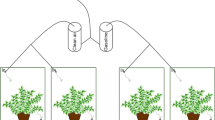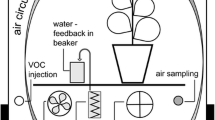Abstract
We conducted laboratory tests with six species of plants to determine their ability to remove benzene, trichloroethylene (TCE) and toluene from air. The objective of this proof-of-principal study was to evaluate the idea that phytoremediation techniques might be used to lower the concentrations of indoor air pollutants, such as volatile or semi-volatile organic compounds. Plants were exposed to the pollutants singly or in mixtures in an airtight chamber, and concentrations of the pollutants in the chamber were monitored through time to assess plant effects on the pollutants. In several experiments, we measured air temperature and CO2, as well. Lower surfaces of leaves of several of the species we tested were also examined by scanning electron microscopy to determine stomate abundance and size, and to provide information about leaf-surface elemental composition (by X-ray emission spectroscopy). Several of the species demonstrated an extensive ability to remove benzene from air. Gas chromatography methods allowed a reasonably direct, continuous monitoring of the kinetics and overall efficiency of the pollutant-removal process. We found that pollutant removal efficiency varied in response to plant species and the pollutant. Of the pollutants tested, benzene was most efficiently removed from air by Pelargonium domesticum, Ficus elastica and Chlorophytum comosum. Kalanchoe blossfeldiana, a common ornamental plant, appeared to take up benzene selectively over toluene, and TCE was removed efficiently from the air by C. comosum. Pentane, sometimes used as an internal standard in GC/MS, was removed from air by at least four of the species. For C. comosum, TCE appeared to lower the removal rates of benzene and pentane. Low-vacuum scanning electron microscopy provided information on stomate size and density and permitted rapid initial elemental analysis of the plant-leaf surface by X-ray emission spectroscopy. Our results indicate that simple tests for pollutant uptake, morphological and chemical features of plants, and plant detoxification enzyme activity might be used in multivariate fashion to identify plant species capable of removing volatile or semi-volatile pollutants from air.
Similar content being viewed by others
References
Anderson, T.A., Guthrie, E.A. and Walton, B.T. (1993). Bioremediation in the rhizosphere. Environ. Sci. Technol. 27, 2630-2636.
Aoyagi, Y., Kasuga, A., Fujihara, S. and Sugahara, T. (1995). Isolation of antioxidative compounds from Saxifraga stolonifera. J. Jap. Soc. Food Sci. Technol. 42, 1027-1030.
Baker, A.J.M., Brooks, R.R. and Reeves, R.D. (1989). Growing for gold... and copper... and zinc. New Scientist 10, 44-48.
Berti, W.R. and Cunningham, S.D. (1994). Remediating soil lead with green plants. In C.R. Cothern (ed.), Trace Substances, Environment and Health. Science Reviews.
Brown, K.S. (1995). The green clean. Bioscience 45, 579-582.
Cooney, C.M. (1996). Sunflowers remove radionuclides from water in ongoing phytoremediation field test. Environ. Sci. Technol. 30, 194.
Cornejo, J.J. and Muñoz, F.G. (1997). Studies on bioremediation: Decontamination of indoor air with plants of the Chilean flora. Primer Congreso Iberoamericano de Quimica y Fisica Ambiental, Termas de Jahuel, Chile, October 20–24.
Cornejo, J.J., Muñoz, F.G., Ma, C.Y., Stewart, A.J. and Thundat, T. (1998). Methodologies for real-time analysis of the decontamination ability of Chilean plants. IV. Encuentro de Quimica Analitica y Ambiental, Antofagasta, Chile, October 27–30.
Gehrig, H., Taybi, T., Kluge, M. and Brulfert, J. (1995). Identification of multiple PEPC isogenes in leaves of the facultative Crassulacean Acid Metabolism CAM plant Kalanchoe blossfeldiana poelln cv Tom Thumb. FEBS Letters 377, 399-402.
Giese, M., Bauerdoranth, U., Langebartels, C. and Sandermann, H. (1994). Detoxification of formaldehyde by the spider plant (Chlorophytum-comosum L) and by soybean (Glycine-max L) cell-suspension cultures. Plant Physiol. 104, 1301-1309.
Glass, D.J. (1997). Evaluating phytoremediation's potential share of the remediation market. In IBC's. Second Annual Conference of Phytoremediation, Seattle, WA, June 18–19.
Gordon, M., Choe, N., Duffy, J., Ekuan, G., Heilman, P., Muiznieks, I., Ruszaj, M., Shurtleff, B.B., Strand, S., Wilmoth, J. and Newman, L.A. (1998). Phytoremediation of trichloroethylene with hybrid poplars. Environ. Health Perspect. 4, 1001-1004.
Hiatt, M.H. (1998). Bioconcentration factors for volatile organic compounds in vegetation. Anal. Chem. 70, 851-856.
Horn, W. (1994). Interspecific crossability and inheritance in Pelargonium. Plant Breeding 113, 3-17.
Kadlec, R.H. and Knight, R.L. (1996). Treatment Wetlands. Boca Raton, FL: CRC Press.
Khatisashvili, G., Gordeziani, M., Kvesitadze, G. and Korte, F. (1997). Plant monoxigenases: Participation in xenobiotic oxidation. Ecotoxicol. Environ. Saf. 36, 118-122.
Landrigan, P.J. and Watanabe, A.S. (1987). Common-source community and industrial exposure to VOCs. Arch. Environ. Health 42, 327-332.
Lopez, M.F. and Skea, W.M. (1994). A glutathione S-transferase (GST) isozime from broccoli with significant sequence homology to mammalian theta-class of GSTs. Biochim. Biophys. Acta 1205, 29.
Ma, C.Y., Skeen, J.T., Dindal, A.B., Bayne, J.T. and Jenkins, R.A. (1997). Performance evaluation of a thermal desorption/gas chromatographic/mass spectrometry method for the characterization of waste tank headspace samples. Environ. Sci. Technol. 31, 853-859.
Martinez, M.C., Achkor, H., Persson, B., Fernandez, M., Shafqat, J., Farres, J., Jornvall, H. and Pares, X. (1996). Molecular properties of plant class III alcohol dehydrogenase provide further insights into the origins, structure and function of plant class p and liver class I alcohol dehydrogenase. Eur. J. Biochem. 241, 849-857.
Moffat, A.S. (1995). Plants proving their worth in toxic metal cleanup. Science 269, 302-303.
Newman, L.A., Strand, S.E., Choe, N., Duffy, G., Ekuan, G., Ruszaj, M., Shurtleff, B.R., Wilmoth, J., Heilman, P. and Gordon, M.P. (1997). Uptake and biotransformation of trichloroethylene by hybrid poplars. Environ. Sci. Technol. 31, 1062-1067.
Radwan, S., Sorkhoh, N. and El-Nemr, I. (1995). Oil biodegradation around roots. Nature 376, 302.
Rugh, C.L. (1996). Mercury ion reduction and resistance in transgenic Arabidopsis thaliana plant expressing a modified bacterial merA gene. Proc. Natl. Acad. Sci. USA. 93, 3182-3187.
Salt, D.E., Blaylock, M., Kumar, N.P., Dushenkov, V., Ensley, B.D., Chet, I. and Raskin, I. (1995). Phytoremediation: A novel strategy for the removal of toxic metals from the environment using plants. Biotechnology 13, 468-474.
Sandermann, H., Langebertels, C., Baurerdoranth, U. and Giese, M. (1994). Detoxification of formaldehyde by the spider plant Chlorophytum comosum and by soybean (Glycine max L) cell-suspension culture. J. Plant Physiol. 104, 1301-1309.
Sanderman, H., Schmitt, R., Eckey, H. and Bauknecht, T. (1996). Plant biochemistry of xenobiotics: Isolation and propieties of soybean O-and N-malonyltransferases for chlorinated phenols and anilines. Arch. Biochem. Biophys. 287, 341-350.
Saxe, H. (1994). Relative sensitivity of greenhouse pot plants to long-term exposures of NO-containing and NO2-containing air. Environ. Pollut. 85, 283-290.
Ugrekhelidze, D., Korte, F. and Kvesitadze, G. (1997). Uptake and transformation of benzene and toluene by plant leaves. Ecotoxicol. Environ. Saf. 37, 24-29.
Watanabe, M.E. (1997). Phytoremediation on the brink of commercialization. Environ. Sci. Technol. 31, 182-186.
Wu, C.C. and KuoHuang L.L. (1997). Calcium crystals in the leaves of some species of Moraceae. Bot. Bull. Acad. Sinica 38, 97-104.
Author information
Authors and Affiliations
Rights and permissions
About this article
Cite this article
Cornejo, J.J., Muñoz, F.G., Ma, C.Y. et al. Studies on the Decontamination of Air by Plants. Ecotoxicology 8, 311–320 (1999). https://doi.org/10.1023/A:1008937417598
Issue Date:
DOI: https://doi.org/10.1023/A:1008937417598




